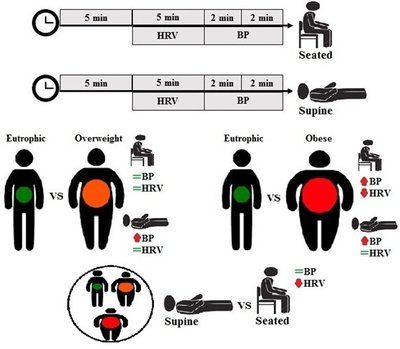-
Home
-
About JCTR
-
Gold Open Access
-
Issues
-
Editorial board
-
Author guidelines
-
Publication fees
-
Online first
-
Special issues
-
News
-
Publication ethics
-
Partners
-
Submit your manuscript
-
Submit your review report
-
Editorial Office
-

This work is licensed under a Creative Commons Attribution-NonCommercial 4.0 International License. ISSN print: 2382-6533 ISSN online: 2424-810X
Volume 3 Issue 3
Higher blood pressure and lower cardiac vagal activity in obese young individuals in supine and seated position
André Rodrigues Lourenço Dias, Katrice Almeida de Souza, Laila Cândida de Jesus Lima de Sousa, Kamila Meireles dos Santos, Gabriel Kolesny Tricot, Jaqueline Alves de Araújo, Lucieli Teresa Cambri, Gisela Arsa
Dias et al., J Clin Transl Res, 2017, 3(3): 2
Published online: September 23, 2017
Abstract
Background: Obesity triggers alterations in hemodynamic and autonomic control. There are few studies that investigate the effects of overweight and obesity in early adulthood on hemodynamic and autonomic variables.
Aim: The aim of this study was to determine whether overweight and obesity in young individuals cause alterations in hemodynamic parameters and heart rate variability (HRV) in supine and seated position, and to correlate these variables with anthropometric features.
Methods: Measurements were performed in 40 young untrained male study participants. The subjects were eutrophic (22.8 ± 0.3 kg/m2, N = 19), overweight (27.0 ± 0.5 kg/m2, N = 10), and obese (33.5 ± 0.8 kg/m2, N = 11). After 5 min in supine and seated position, the R-R intervals and blood pressure (BP) were recorded.
Results: The systolic blood pressure were higher in overweight (supine, 122.9 ± 2.3 mmHg) and obese (supine, 123.9 ± 2.2; seated, 121.7 ± 2.3 mmHg) individuals compared to eutrophic individuals (supine, 111.8 ± 1.64; seated, 111.3 ± 1.8 mmHg) (p ≤ 0.05). Obese subjects exhibited lower HRV (SD1, RMSSD, pNN50) compared to eutrophic individuals when seated. In obese subjects, the heart rate (HR) increased and HRV decreased (p ≤ 0.05) when seated versus supine position. The body mass, body mass index (BMI), and waist and abdominal circumferences correlated positively with BP (r = 0.40−0.64, p ≤ 0.05), while the BMI, waist circumference, BP, and HR were negatively correlated (r = -0.32−-0.62, p ≤ 0.05) with HRV (pNN50 and HF) in both body positions. BMI, waist circumference, BP, and HR correlated negatively with additional HRV indices (SD1, SD2, RMSSD, PT, and LF) when seated.
Conclusions: Obese and overweight individuals presented higher SBP, and obese individuals had lower HRV and cardiac vagal activity, associated with anthropometric variables.
Relevance for patients: The monitoring of HRV in obese subjects in seated position allows improved prognosis of metabolic consequences to cardiac autonomic control.

DOI: http://dx.doi.org/10.18053/jctres.03.201703.002
Author affiliation
1 Graduate Program on Physical Education, Federal University of Mato Grosso, Cuiabá, Mato Grosso, Brazil
2 Graduate Program on Physical Education, Catholic University of Brasilia, Taguatinga, Federal District, Brazil
*Corresponding author
Gisela Arsa
Graduate Program on Physical Education, Federal University of Mato Grosso, Cuiabá, Mato Grosso, Brazil
Tel: +55 65 3615-8836
Email: gisarsa@gmail.com
Handling editor:
Rowan van Golen
Gastroenterology and Hepatology, Leiden University Medical Center, Leiden, the Netherlands

